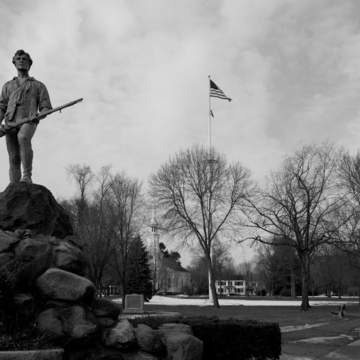Lexington Green, most significant as the site of the first encounter of the American Revolution, is surrounded by a group of eighteenth- and nineteenth-century structures, many with their own claims to significance. Used as pasture for animals and haying well into the nineteenth century, the Green also became a commemorative site in 1799 when an early example of an obelisk monument by Thomas Park was erected in memory of the eight Minutemen who died on the morning of April 19, 1775. In 1898, the statue of a Lexington Minuteman by Henry H. Kitson was
The surrounding buildings retain their nineteenth-century appearance to a remarkable degree, and exemplify the nineteenth-century setting of many town commons in the region. Proud of the commemorative nature of the area, owners established one of the earliest (1917) preservation covenants in the country, placing restrictions in their deeds disallowing commercial use of their properties, specifying a uniform setback, and limiting new construction to a single building. The cohesive assemblage of primarily white-painted, modest, wood-frame structures includes the three oldest houses that were restored in the early twentieth century to reflect their colonial origins. The threatened demolition of the mid-eighteenth-century Jonathan Harrington House (1 Harrington Road, NRD) was one of the factors that prompted William Sumner Appleton to found the Society for the Preservation of New England Antiquities (now Historic New England, Inc.).
The Green's most prominent building is the First Parish Church (1847, 7 Harrington Road, NRD), designed by local architect Isaac Melvin, who successfully combined Greek Revival church architecture with a steeple that harks back to alternative steeple designs for St. Martin-in-the-Fields, London, and was published in James Gibbs's Book of Architecture (1728). The Academy building (1822, 3 Bedford Street), originally a gable-fronted structure with a dome-topped cupola, housed the first normal school in Massachusetts (dedicated to training teachers) from 1839 to 1844. The Nathaniel Harrington House (1790, NRD), Lexington's first brick building, stands at 1888 Massachusetts Avenue. The Hancock Congregational Church (1893, Paine and Lewis; 1950s stuccoed addition, NRD) combines Shingle Style massing with walls of fieldstone.









